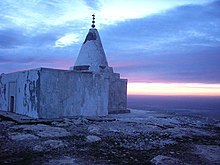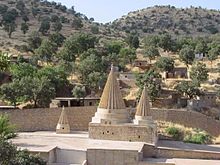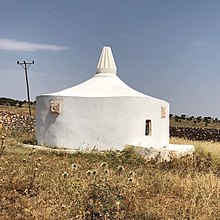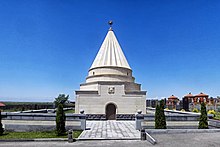
Yazidism, alternatively Sharfadin is a monotheistic ethnic religion that has roots in a western Iranic pre-Zoroastrian religion directly derived from the Indo-Iranian tradition. It is followed by the mainly Kurdish-speaking Yazidis and is based on belief in one God who created the world and entrusted it into the care of seven Holy Beings, known as Angels. Preeminent among these Angels is Tawûsî Melek, who is the leader of the Angels and who has authority over the world.

Sinjar is a town in the Sinjar District of the Nineveh Governorate in northern Iraq. It is located about five kilometers south of the Sinjar Mountains. Its population in 2013 was estimated at 88,023, and is predominantly Yazidi.

Lalish is a mountain valley and temple in Shekhan, Duhok Governorate in Iraq. It is the holiest temple of the Yazidis. It is the location of the tomb of the Sheikh Adi ibn Musafir, a central figure of the Yazidi faith.

The 2007 Yazidi communities bombings occurred on August 14, 2007, when four coordinated suicide car bomb attacks detonated in the Yazidi towns of Til Ezer (al-Qahtaniyah) and Siba Sheikh Khidir (al-Jazirah), in northern Iraq.

Til Ezer is a village located in the Sinjar District of the Ninawa Governorate in Iraq. The village is located south of the Sinjar Mount, in the disputed territories of Northern Iraq.

Yazidis or Yezidis are a Kurdish-speaking endogamous group who are indigenous to Kurdistan, a geographical region in Western Asia that includes parts of Iraq, Syria, Turkey and Iran. The majority of Yazidis remaining in the Middle East today live in Iraq, primarily in the governorates of Nineveh and Duhok.
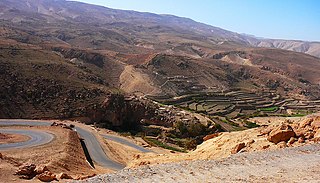
The Sinjar Mountains, are a 100-kilometre-long (62 mi) mountain range that runs east to west, rising above the surrounding alluvial steppe plains in northwestern Iraq to an elevation of 1,463 meters (4,800 ft). The highest segment of these mountains, about 75 km (47 mi) long, lies in the Nineveh Governorate. The western and lower segment of these mountains lies in Syria and is about 25 km (16 mi) long. The city of Sinjar is just south of the range. These mountains are regarded as sacred by the Yazidis.

The Sinjar District or the Shingal District is a district of the Nineveh Governorate. The district seat is the town of Sinjar. The district has two subdistricts, al-Shemal and al-Qayrawan. The district is one of two major population centers for Yazidis, the other being Shekhan District.

Hemoye Shero, Hamu Shiru,, was a nineteenth century Yezidi tribal leader from the Shingal Mountains in what was the Ottoman Empire is now part of northern Iraq. Hemoye Shero was instrumental in transforming one of the Yezidi social classes, the Fakirs, into a tribal entity and establishing himself as the chief.

A genocide of Yazidis by the Islamic State was carried out in the Sinjar area of northern Iraq in the mid-2010s. The genocide led to the expulsion, flight and effective exile of the Yazidis. Thousands of Yazidi women and girls were forced into sexual slavery by ISIL, and thousands of Yazidi men were killed. About 5,000 Yazidi civilians were killed during what has been called a "forced conversion campaign" carried out by ISIL in Northern Iraq. The genocide began after the withdrawal of Iraqi forces and Peshmerga, which left the Yazidis defenseless.
Sheikh Khairy Khedr was the Commander and founder of the Yazidi militia Malik Al-Tawus Troop, which later became the Sinjar Resistance Units (YBŞ). He was born in Siba Sheikh Khidir (Jazeera).
Siba Sheikh Khidir is a village located in the Sinjar District of the Ninawa Governorate in Iraq. The village is located south of the Sinjar Mount. It belongs to the disputed territories of Northern Iraq. Siba Sheikh Khidir is populated by Yazidis and was one of two villages targeted in the 2007 Yazidi communities bombings against the local Yazidi community.
Sharya is a town located in the Simele District of the Dohuk Governorate in Kurdistan Region of Iraq. The town is located ca. 15 kilometres (9.3 mi) south of Dohuk.

The persecution of Yazidis has been ongoing since at least 637 CE. Yazidis are an endogamous and mostly Kurmanji-speaking minority, indigenous to Kurdistan. The Yazidi religion is regarded as "devil-worship" by Muslims and Islamists. Yazidis have been persecuted by the surrounding Muslims since the medieval ages, most notably by Safavids, Ottomans, neighbouring Muslim Arab and Kurdish tribes and principalities. After the 2014 Sinjar massacre of thousands of Yazidis by ISIL, which started the ethnic, cultural, and religious genocide of the Yazidis in Iraq, Yazidis still face discrimination from the Iraqi government and the Kurdistan Regional Government.
There is a social organizational structure in the Yazidi community. There are three main castes, namely the Mirids, the Sheikhs, and the Pirs. Furthermore, there are positions for dignitaries in the Yazidi hierarchy.
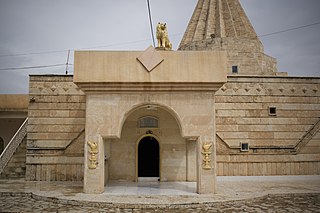
Pir Mam Rashan or Pir Mehmed Reshan was a 12th-century Yazidi saint. The Mam Rashan Shrine on Mount Sinjar was built in honor of him.

Yazidism in Iraq refers to adherents of Yazidism from Iraq who reside mainly in the districts of Shekhan, Simele, Zakho and Tel Kaif, in Bashiqa and Bahzani, and the areas around Sinjar mountains in Sinjar district. According to estimates, the number of Yazidis in Iraq is up to 700,000. According to the Yazda aid organization, just over half a million Yazidis lived throughout Iraq before August 2014.
Alphabetical index of articles about the Yazidis, and their history and culture.
